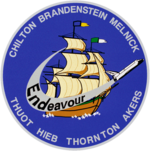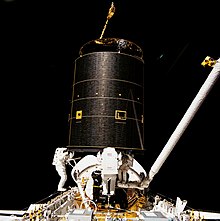STS-49
| Mission emblem | |||
|---|---|---|---|

|
|||
| Mission dates | |||
| Mission: | STS-49 | ||
| COSPAR-ID : | 1992-026A | ||
| Crew: | 7th | ||
| Begin: | May 7, 1992, 23:40:00 UTC | ||
| Starting place: | Kennedy Space Center , LC-39B | ||
| Landing: | May 16, 1992, 20:57:38 UTC | ||
| Landing place: | Edwards Air Force Base , Runway 22 | ||
| Flight duration: | 8d 21h 17min 38s | ||
| Earth orbits: | 141 | ||
| Rotation time : | 91.9 min | ||
| Orbit inclination : | 28.3 ° | ||
| Apogee : | 375 km | ||
| Perigee : | 363 km | ||
| Covered track: | 5.9 million km | ||
| Team photo | |||
 v. l. No. Richard Hieb, Kevin Chilton, Daniel Brandenstein, Thomas Akers, Pierre Thuot, Kathryn Thornton, Bruce Melnick |
|||
| ◄ Before / After ► | |||
|
|||
STS-49 ( english S pace T ransportation S ystem ) is a mission designation for the US Space Shuttle Endeavor (OV-105) of NASA . The launch took place on May 7, 1992. It was the 47th space shuttle mission and the maiden flight of the space shuttle Endeavor.
team
- Daniel Brandenstein (4th space flight), commander
- Kevin Chilton (1st spaceflight), pilot
- Pierre Thuot (2nd space flight), mission specialist
- Kathryn Thornton (2nd spaceflight), mission specialist
- Richard Hieb (2nd space flight), mission specialist
- Thomas Akers (2nd space flight), mission specialist
- Bruce Melnick (2nd Spaceflight), Mission Specialist
Mission overview
A so-called flight readiness firing took place in preparation for the mission . During the test, in which the space shuttle remains on the ground, the main engines are ramped up after a normal countdown to 100 percent power at T = 0. This engine test is carried out each time a US space shuttle takes off for the first time.
May 4, 1992 at 00:34 UTC was originally named as the start date. However, this was postponed by two days, as it enabled better images of the shuttle taking off. The take-off was postponed by 34 minutes due to bad weather at a TAL (Transoceanic Abort Landing) landing site and finally took place on May 7, 1992 at 23:40 UTC.

The main objective of the mission was to capture the Intelsat 603 satellite . This satellite was stranded in an orbit that was too low two years earlier due to a failure to disconnect the second stage rocket. For the first time in history, a rocket engine on a satellite was to be replaced. This task required three attempts, although only one attempt was planned. During the first two space exits (EVA), the two space travelers Pierre Thuot and Richard Hieb were unable to capture the satellite. It was decided that a third astronaut should help. This was the first and so far only three-man extraterrestrial mission. Thomas Akers caught the satellite together with Thout and Hieb and then the engine was assembled together.
The Assembly of Station by EVA Methods experiment (ASEM) was carried out during a fourth exit by the Thornton-Akers duo . It should show that an in-orbit space station can be assembled and maintained. This task was accomplished, but only one of the originally planned two exits was carried out as the work on the Intelsat satellite was too time-consuming. Due to the problems with catching the satellite, it was the first shuttle mission with four EVAs. In addition, at 25 hours and 27 minutes, this mission had the highest total EVA duration of any previous shuttle mission.
The Endeavor landed on May 16, 1992 at 20:57:38 UTC on runway 22 of Edwards Air Force Base . A braking parachute was used for the first time on the American shuttles . On the Shuttle Carrier Aircraft , the space shuttle was brought back to the Kennedy Space Center on May 30th .
The mission had the following highlights and innovations:
- The second longest EVA at the time (after STS-102 ) with 8 hours and 29 minutes
- First shuttle mission with three rendezvous to an in-orbit satellite.
See also
Web links
- NASA Mission overview (English)
- Video summary with comments of the crew (English)
- Nasa-STS-49 (47) (English)
- STS-49 in the Encyclopedia Astronautica (English)
